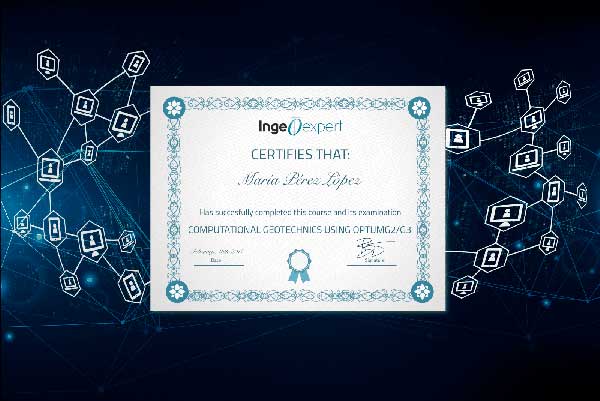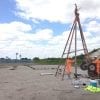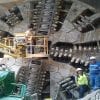Design and construction of large diameter foundation bored piles
Online course |
|
50 hours / 6 weeks |
|
|
Dates: 25th of November to 6th of January |
| Standard | Unemployed Or Student |
| $313 | $216 |
RSPile software temporary license will be provided for the course attendees
Introduction
This six-weeks course is intended to include material that can be basis of design for bored piles. The presented subjects will be more towards practical methods used for design and the theoretical origins of those methods. Construction methods and tolerances will also be passed over. Mainly, ICE SPERW will be the basis for construction specifications. Comprehensive explanation of ACI codes and committees and some of EC provisions is presented.
The modules are devoted to both geotechnical and structural design of bored piles. The geotechnical part includes the estimation of the carrying capacity of the piles, the safety factors, the settlement at working loads, the lateral load analysis, the group effect and static load tests. While the structural part comprises of determination of required longitudinal reinforcement, shear reinforcement, crack width control and a rapid overview of factors that control the service lifetime of the piles.
Objectives
Subjects given in this course cannot be found in a single textbook. The aim of the course is to gather enough information about the design and construction of bored piles for engineers intending to challenge this field. Also, it is useful for civil/geotechnical engineering students that have finished a first course in soil mechanics or geotechnical engineering or postgraduate students who would like to continue research about bored piles and deep foundations. On the other hand, structural engineers that use piles in their designs shall be greatly benefited from the methods and information introduced.
Limited places.
- Module 1. Piles and Bored Pile Construction
- Pile Foundation- Definition
- Pile Types- Bored Piles
- Construction of Bored Piles
- ICE SPERW, ACI 336, EC7
- Casings: Alignment Installation and Extraction, Boring: Augers and Buckets, Drilling Mud or Fluid, Cleaning Bucket
- Steel Cage Preparation: Spacers
- Concreting: Pumping, Tremie Pipes, Slump, Temperature
- Tolerances BS8004, EC7, ICE SPERW, ACI 117
- Module 2. Bore Piles Carrying Capacity
- General Mechanism
- Estimating Skin Resistance in Cohesionless Soil
- Beta Method
- Lateral pressure coefficient methods
- Estimating Skin Resistance in Cohesive Soils
- The Alpha Method
- Weak Rocks
- DM7-Method
- Williams and Pells Method
- Other Methods in Weak Rocks
- Estimation of End Bearing Resistance in Cohesionless Soils
- Estimation of End Bearing Resistance in Cohesive Soils
- Estimation of End bearing Resistance in weak rocks
- SPT Methods
- Module 3. Pile Behavior and Pile Groups
- Settlement Calculations
- Vesic Method- Q-z, T-z Methods
- Pile Behavior under Lateral Loads
- Free Head Piles- Fixed Head Piles in Cohesive and Cohesionless soils.
- Lateral Behavior in Weak Rocks
- P-Y Methods.
- Pile Group Effects
- Negative Skin Friction
- Software Example: RSPile
- Module 4. Pile Design- Geotechnical Considerations
- Factors of Safety
- Pile Length Calculations
- Average Stresses
- ASD Approach
- LRFD Service Load Combinations ACI 336
- Module 5. Pile Design- Structural Considerations
- LRFD Ultimate Load Combinations ACI 318/ ASCE 7
- Design for Combined Axial Force and Bending Moment
- Design for Shear
- Control of Crack Width
- Overlaps and Dowel Lengths of Reinforcement
- Buckling and Above COL Loads
- Module 6. Static Load tests
- Methods of Load Application ICE SPERW and ASTM D 1143
- Required Test Types and Data Forms
- Specifications and Dimensions
- Pile Caps
- Uplift Tests (Tension Tests)
- Lateral Load Tests
- O-Cell BDSLT Tests
- Results Interpretation
Ahmed Mufty
Ass. Prof. Ahmed Mufty, Ph.D., MISSMGE completed his studies in the department of civil engineering in the university of Baghdad. He earned his B.Sc. in 1985. He continued his postgraduate study in geotechnical engineering and got his M.Sc. in 1990 and his Ph.D. in 1997. Dr. Mufty started his practical life with piles early after graduation. He started lecturing 1992 and became a faculty member in the department of civil engineering of the university of Baghdad for the period 1995-2004. After 2004, he moved to UAE and worked in pile design and construction till 2019 when he moved to Rocscience Inc. in Toronto joining the geotechnical software team as geomechanics specialist.
Dr. Mufty has more than 34 years of practical and theoretical experience in civil and geotechnical engineering and accomplished designs with full technical management for shoring of deep excavations and pile foundations for more than 100 iconic projects in Iraq, UAE, Qatar, KSA, Oman, India and Canada. He is also expert in many other fields of geotechnical engineering. He supervised 11 M.Sc. and Ph.D. Students and authored/co-authored more than 15 technical articles, one book in Arabic and 5 other public notes.
The course is delivered online through our easy-to-use Virtual Campus platform. For this course, a variety of content is provided including:
– eLearning materials
– Videos
– Interactive multimedia content
– Live webinar classes
– Texts and technical articles
– Case studies
– Assignments and evaluation exercises
Students can display the materials and work through the course at their own pace.
We regularly update this course to ensure the latest news and state-of-the-art developments are covered, and your knowledge of the subject is current.
Live webinars form part of our course delivery. These allow students and tutors to go through the course materials, exchange ideas and knowledge, and solve problems together in a virtual classroom setting. Students can also make use of the platform’s forum, a meeting point to interact with tutors and other students.
The tutoring system is managed by email. Students can email the tutor with any questions about the course and the tutor will be happy to help.
- – Engineers who are intending to work or working already in design or construction of bored piles.
- – Post graduate students who would like to continue their research work in the field of bored piles
- – Civil/ Geotechnical engineering students who completed a preliminary course in geotechnical engineering and want to move to more advanced studies.
- – Consultant engineers and regulatory authority engineers who are responsible of reviewing/ approving geotechnical designs of others or in design/build contracts.
- – Consultants who prepare and issue specifications for design and construction of bored piles.
- – A pre-requirement for this course is knowledge of reinforced concrete beam-column design and essential soil mechanics.
Once a student finishes the course and successfully completes the assignments and evaluation tests, they are sent an accreditation certificate. The certificate is issued by Ingeoexpert to verify that the student has passed the course. It is a digital certificate that is unique and tamper-proof – it is protected by Blockchain technology. This means it is possible for anyone to check that it is an authentic, original document.
You will be able to download the certificate in an electronic format from the Virtual Campus platform. The certificate can be forwarded by email, shared on social networks, and embedded on websites. To see an example, click here.
Bored piles are the most reliable and durable foundation for heavy buildings. Bored piles transfer the loads of the building to deep strong strata. Design of piles is a hot subject and jobs for pile designers are always available especially in developing areas around the world. It is one of the best careers a geotechnical engineer may work at.
RSPile software temporary license will be provided for the course attendees
Introduction
This six-weeks course is intended to include material that can be basis of design for bored piles. The presented subjects will be more towards practical methods used for design and the theoretical origins of those methods. Construction methods and tolerances will also be passed over. Mainly, ICE SPERW will be the basis for construction specifications. Comprehensive explanation of ACI codes and committees and some of EC provisions is presented.
The modules are devoted to both geotechnical and structural design of bored piles. The geotechnical part includes the estimation of the carrying capacity of the piles, the safety factors, the settlement at working loads, the lateral load analysis, the group effect and static load tests. While the structural part comprises of determination of required longitudinal reinforcement, shear reinforcement, crack width control and a rapid overview of factors that control the service lifetime of the piles.
Objectives
Subjects given in this course cannot be found in a single textbook. The aim of the course is to gather enough information about the design and construction of bored piles for engineers intending to challenge this field. Also, it is useful for civil/geotechnical engineering students that have finished a first course in soil mechanics or geotechnical engineering or postgraduate students who would like to continue research about bored piles and deep foundations. On the other hand, structural engineers that use piles in their designs shall be greatly benefited from the methods and information introduced.
Limited places.
- Module 1. Piles and Bored Pile Construction
- Pile Foundation- Definition
- Pile Types- Bored Piles
- Construction of Bored Piles
- ICE SPERW, ACI 336, EC7
- Casings: Alignment Installation and Extraction, Boring: Augers and Buckets, Drilling Mud or Fluid, Cleaning Bucket
- Steel Cage Preparation: Spacers
- Concreting: Pumping, Tremie Pipes, Slump, Temperature
- Tolerances BS8004, EC7, ICE SPERW, ACI 117
- Module 2. Bore Piles Carrying Capacity
- General Mechanism
- Estimating Skin Resistance in Cohesionless Soil
- Beta Method
- Lateral pressure coefficient methods
- Estimating Skin Resistance in Cohesive Soils
- The Alpha Method
- Weak Rocks
- DM7-Method
- Williams and Pells Method
- Other Methods in Weak Rocks
- Estimation of End Bearing Resistance in Cohesionless Soils
- Estimation of End Bearing Resistance in Cohesive Soils
- Estimation of End bearing Resistance in weak rocks
- SPT Methods
- Module 3. Pile Behavior and Pile Groups
- Settlement Calculations
- Vesic Method- Q-z, T-z Methods
- Pile Behavior under Lateral Loads
- Free Head Piles- Fixed Head Piles in Cohesive and Cohesionless soils.
- Lateral Behavior in Weak Rocks
- P-Y Methods.
- Pile Group Effects
- Negative Skin Friction
- Software Example: RSPile
- Module 4. Pile Design- Geotechnical Considerations
- Factors of Safety
- Pile Length Calculations
- Average Stresses
- ASD Approach
- LRFD Service Load Combinations ACI 336
- Module 5. Pile Design- Structural Considerations
- LRFD Ultimate Load Combinations ACI 318/ ASCE 7
- Design for Combined Axial Force and Bending Moment
- Design for Shear
- Control of Crack Width
- Overlaps and Dowel Lengths of Reinforcement
- Buckling and Above COL Loads
- Module 6. Static Load tests
- Methods of Load Application ICE SPERW and ASTM D 1143
- Required Test Types and Data Forms
- Specifications and Dimensions
- Pile Caps
- Uplift Tests (Tension Tests)
- Lateral Load Tests
- O-Cell BDSLT Tests
- Results Interpretation
Ahmed Mufty
Ass. Prof. Ahmed Mufty, Ph.D., MISSMGE completed his studies in the department of civil engineering in the university of Baghdad. He earned his B.Sc. in 1985. He continued his postgraduate study in geotechnical engineering and got his M.Sc. in 1990 and his Ph.D. in 1997. Dr. Mufty started his practical life with piles early after graduation. He started lecturing 1992 and became a faculty member in the department of civil engineering of the university of Baghdad for the period 1995-2004. After 2004, he moved to UAE and worked in pile design and construction till 2019 when he moved to Rocscience Inc. in Toronto joining the geotechnical software team as geomechanics specialist.
Dr. Mufty has more than 34 years of practical and theoretical experience in civil and geotechnical engineering and accomplished designs with full technical management for shoring of deep excavations and pile foundations for more than 100 iconic projects in Iraq, UAE, Qatar, KSA, Oman, India and Canada. He is also expert in many other fields of geotechnical engineering. He supervised 11 M.Sc. and Ph.D. Students and authored/co-authored more than 15 technical articles, one book in Arabic and 5 other public notes.
The course is delivered online through our easy-to-use Virtual Campus platform. For this course, a variety of content is provided including:
– eLearning materials
– Videos
– Interactive multimedia content
– Live webinar classes
– Texts and technical articles
– Case studies
– Assignments and evaluation exercises
Students can display the materials and work through the course at their own pace.
We regularly update this course to ensure the latest news and state-of-the-art developments are covered, and your knowledge of the subject is current.
Live webinars form part of our course delivery. These allow students and tutors to go through the course materials, exchange ideas and knowledge, and solve problems together in a virtual classroom setting. Students can also make use of the platform’s forum, a meeting point to interact with tutors and other students.
The tutoring system is managed by email. Students can email the tutor with any questions about the course and the tutor will be happy to help.
- – Engineers who are intending to work or working already in design or construction of bored piles.
- – Post graduate students who would like to continue their research work in the field of bored piles
- – Civil/ Geotechnical engineering students who completed a preliminary course in geotechnical engineering and want to move to more advanced studies.
- – Consultant engineers and regulatory authority engineers who are responsible of reviewing/ approving geotechnical designs of others or in design/build contracts.
- – Consultants who prepare and issue specifications for design and construction of bored piles.
- – A pre-requirement for this course is knowledge of reinforced concrete beam-column design and essential soil mechanics.
Once a student finishes the course and successfully completes the assignments and evaluation tests, they are sent an accreditation certificate. The certificate is issued by Ingeoexpert to verify that the student has passed the course. It is a digital certificate that is unique and tamper-proof – it is protected by Blockchain technology. This means it is possible for anyone to check that it is an authentic, original document.
You will be able to download the certificate in an electronic format from the Virtual Campus platform. The certificate can be forwarded by email, shared on social networks, and embedded on websites. To see an example, click here.
Bored piles are the most reliable and durable foundation for heavy buildings. Bored piles transfer the loads of the building to deep strong strata. Design of piles is a hot subject and jobs for pile designers are always available especially in developing areas around the world. It is one of the best careers a geotechnical engineer may work at.
1 review for Design and construction of large diameter foundation bored piles
More info
Finish this course and get a certificate based on Blockchain
Design and construction of large diameter foundation bored piles

Blockchain technology makes the certificate incorruptible, enabling companies to verifiy its autenticity.
Design and construction of large diameter foundation bored piles
| $313 | $216 | |
| Get more information |




Michael Denteh –
Detailed and practical course content.